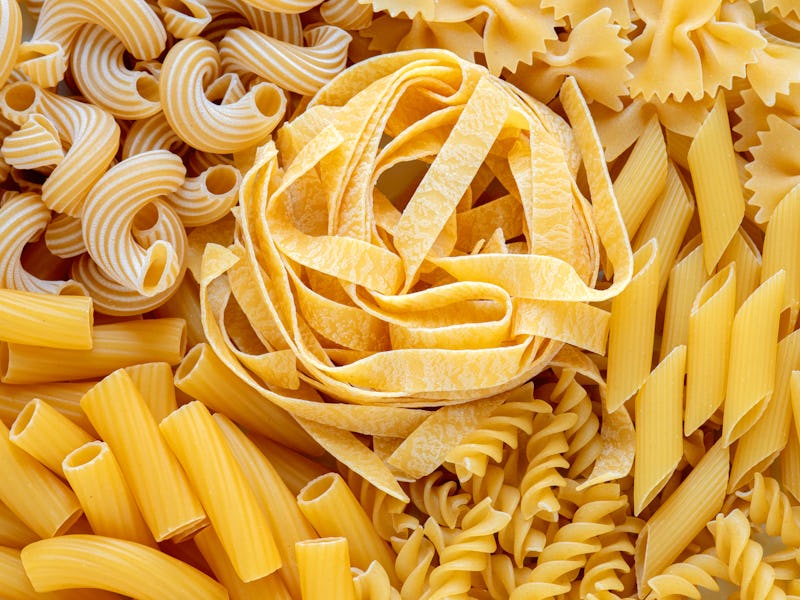Should we abandon good pasta? A dietitian digs in on “healthier” alternatives
There’s a place on the plate for all types of pasta.

If there’s ever doubt that there’s enough room in the world for a multiplicity of shapes and sizes, look at pasta. The same truth holds when it comes to pasta composition. There isn’t simply one pasta recipe, but a whole constellation of them, and each one offers something different.
Typical dry, boxed pasta often contains enriched flour, meaning nutrients like iron and vitamin B are added back after the refining process removes them. Grinding the entire semolina kernel, on the other hand, leads to whole-grain flour, which is coarser — this is also the difference between white bread and whole-wheat bread. Whole-wheat pasta is brown and has a coarse, grainy mouthfeel.
Among the pasta permutations available today are high-protein options made from chickpea or lentil flour, which is grainy but not as coarse as whole semolina flour. If high-protein pasta is an option, should everyone who is able to choose bean rotini over refined flour?
Most pasta comes from refined semolina flour, leaving a soft, chewy noodle without much fiber.
How does protein-based pasta differ from typical pasta?
Here are some basic nutrition facts on dry, boxed flour pasta, and chickpea flour pasta.
One two-ounce serving of refined flour penne pasta:
- 42 g carbohydrates (out of about 250 g recommended daily)
- 3 g fiber (of about 30 g recommended daily)
- 7 g protein (of about 55 g recommended daily)
One two-ounce serving of chickpea-flour penne pasta:
- 35 g carbohydrates
- 5 g fiber
- 11 g protein
Garbanzo (chickpea) pasta gets a bit of a health halo because it’s lower in carbohydrates and higher in fiber and protein. Some may jump to the conclusion that chickpea pasta is therefore superior to refined pasta, but registered dietitian Mudita Arora from Lexington, Kentucky says that’s not true.
Both carbohydrates and protein, she says, have their place in a balanced diet. Carbohydrates energize us, and protein keeps us feeling satisfied. Unlike refined carbohydrates, lentils and garbanzo beans also bring fiber to the gut, which promotes good bacteria. Research suggests the more diverse a person’s gut microbiome is, the healthier they are. Plating refined pasta with high-fiber vegetables like broccoli — whole or in a sauce — could fulfill this criterion too.
The two do differ in taste and texture. Al dente pasta might be described as soft and chewy with a mostly smooth feeling. While chickpea pasta resembles its counterpart in many ways, some describe it as having a neutral flavor or grainer texture that distinguishes it, though sauce may mask these differences.
Perhaps most notably, the two types of pasta differ in price. One pound of refined boxed pasta may sell for less than $2, but just 8 ounces of chickpea pasta can run up to more than twice that, making chickpea pasta at least four times as expensive as refined.
A good sauce is an added bonus to any type of pasta.
Who benefits most from high-protein pasta?
Some pasta-lovers may reap more benefits than others from chickpea pasta. A kid who’s a picky eater may only like a plain plate of noodles with a little bit of butter. Garbanzo pasta could be a great way to make sure they get ample fiber and protein — but force-feeding isn’t necessary. Arora prioritizes enjoying the foods one eats. “The experience should not be a nightmare for a child,” she says, “it should be a fun and pleasurable as opposed to ‘Oh, I have to eat it now.’”
Those managing diabetes could also benefit from lentil pasta because it’s a way to enjoy a bowl of macaroni without blood sugar levels spiking. Arora would also recommend lentil pasta to those managing their weight or limiting carbohydrates.
Arora also encourages getting away from an all-or-nothing mindset. For those making homemade pasta, mixing refined flour and whole wheat flour or semolina flour creates a bite with a fair amount of softness and some whole-grain goodness. Those who simply love rigatoni might have pasta several times a week. To add more variety to their diet and to ensure sufficient protein and fiber each day, Arora recommends eating high-protein pasta once or twice a week as a respite from refined pasta.
Not everyone needs more protein and fiber in their diet, though. Arora mentions that those with kidney diseases might have trouble processing protein, so refined wheat would be better in that case.
Should I replace all pasta with high-protein pasta?
That’s a hard no, according to Arora.
“You must choose what brings you happiness and health,” she urges.
She examines pasta alternatives as ways to shake up different flavors in our meals, and not simply as nutrition supplements. Different plates of pasta pair well with different sauces, she says. One type of pasta may go great with warm marinara sauce while another is the tastiest in a cold pasta salad. Both chickpea and lentil pasta don’t have to be healthy substitutes for a guilty pleasure, but rather an expansion to one’s repertoire of favorite foods.
So embrace the variety. Luckily, legumes and vegetables can take on so many different shapes and textures so let them serve as inspiration.
CHECK, PLEASE is an Inverse series that uses biology, chemistry, and physics to debunk the biggest food myths and assumptions.
Now read this: Can you refreeze thawed leftovers? A food safety specialist explains the complicated science
This article was originally published on